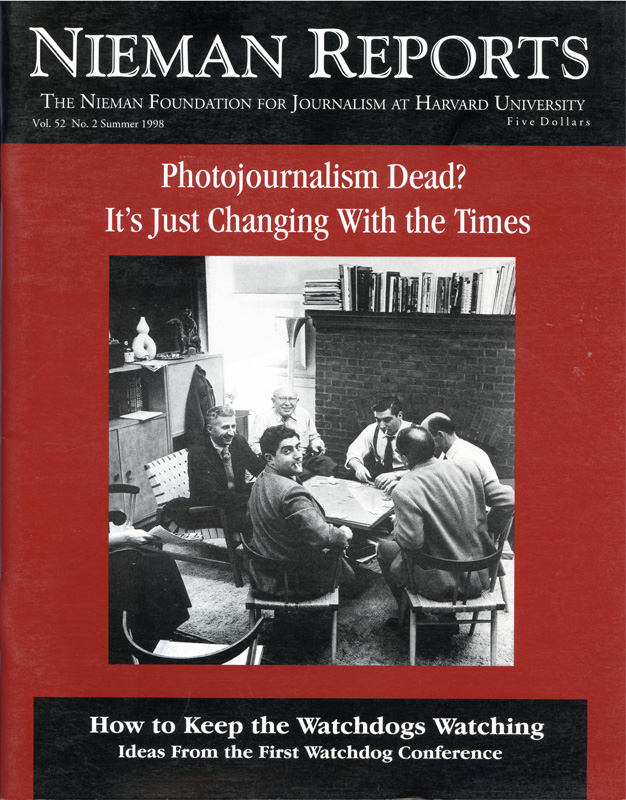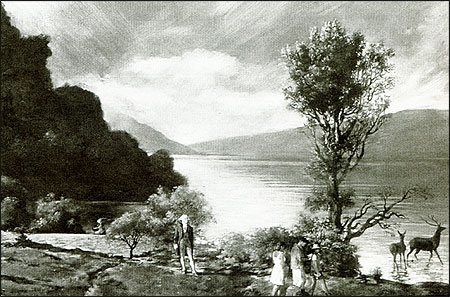
Photojournalism Dead? It's Just Changing With the Times
In the next 50 pages Nieman Reports take stock of photojournalism today. While problems are noted, the report is positive. The articles and the photo essays by 10 Nieman Fellows demonstrate the special value of pictures to news. As noted photographer Edward Steichen summed it up at the dinner celebrating his 90th birthday in 1969: “The mission of photography is to explain man to man and each man to himself. And that is no mean function.”

America’s Most Wanted, 1994. Oil and acrylic on canvas. 24 x 32. By permission of Farrar, Straus and Giroux.
“Painting By Numbers” is a book about art and freedom, authority and control. It’s about beauty: what we think it is and how it fits into our lives. It’s about a few people telling every one else what is good art and what is bad. It’s about class. It’s about blue landscapes. And it sends a message to those who write all kinds of reviews, not just those who write about art.
Two Russian artists, Vitaly Komar and Alexander Melamid, came up with a revolutionary idea when thinking about the kind of art that “regular” people like: they decided to ask them. Filled with imagination, humor, and a surprisingly serious discussion about art, “Painting By Numbers” is the result.
Billed as the “first-ever comprehensive scientific poll of American tastes in art,” the project was commissioned by Komar and Melamid with help from The Nation Institute, a nonprofit outgrowth of The Nation magazine. Marttila & Kiley, Inc., a Boston-based public-opinion research firm, conducted the poll. For 11 days, trained professionals called 1,001 adult Americans asking them what they liked to see in a painting. “Soft curves or sharp angles? Brush strokes or smooth surfaces? Realistic-looking or different-looking? Serious or festive? Outdoor scenes or indoor?” The questions took about 24 minutes to answer.
When the polling results were ready in January of 1994, Komar and Melamid studied the data and then painted two pieces, America’s Most Wanted and America’s Most Unwanted. The paintings were exhibited in a gallery in the SoHo district of New York, followed by extensive public discussion of the project through town meetings in various cities in this country and abroad over the next three years. During this same period, international polling companies in Europe, Asia and Africa made calls similar to the ones made in America. In this manner, the artists insist that they “have surveyed the opinions of close to two billion people—almost one third of the world’s population— and have translated the numbers into paint on canvas.”
What did this extensive polling discover about the world’s taste in art? That everyone’s favorite painting would be of a blue landscape. From Russia to Turkey to Denmark to Kenya, the similarity of preferences was astonishing. For anyone who writes reviews, the issues raised by Komar and Melamid, despite the humor, are disturbing and provocative. The book could have turned into a condescending tract about people with bad taste. It instead questions the nature of art and expertise, as much an examination of those who define what is good art as those who never set foot in a museum or gallery. For instance, instead of mocking the concept of a blue landscape, it is put into another framework entirely. Thinking of the universality of that image, Melamid says that maybe the blue landscape “is genetically imprinted in us, that it’s the paradise within, that we came from the blue landscape and we want it. Maybe paradise is not something which is awaiting us; it is already inside of us, and the point is how to...get it out.”
The art critics involved in the various levels of this project were predictably dismissive of the results; many were surprised that three-fourths of Americans have art in their homes of any quality. But the less explored and more important issue for anyone writing reviews is who has the right to decide what is good and bad? If millions of people like blue landscapes, who is to say they are wrong? What is the role of the expert in our society? How much power should they be allowed? At who’s expense?
One of the most disturbing findings of the poll is that belief “in the public’s right to participate in decisions about public art declines as one moves up the social ladder. About 74 percent of those who make less than $30,000 a year and those in the smallest minority groups think citizens should have a say; whereas a slim majority (54 percent) of those who make more than $75,000 a year think the same....” So again we’re back to the question, what is the role of the expert in our lives?
Usually those not in the art world— the people who spent 24 minutes answering questions and those attending the town meetings—are just as hard on themselves as the art world sophisticates. Most people are able to speak easily and confidently about their views of a movie or a piece of music or a book even if they are not experts. But if you ask them if they like a particular painting, the first comment you will most likely get is an apology, because they feel they know nothing about art. One of the pleasures of “Painting By Numbers” is that we hear from this normally untapped group of people.
The first town meeting was in Ithaca, New York. Every effort was made by the organizers of the project to make people feel comfortable enough to attend and then to speak out (some of the meetings brought in more than 300 people). Speak out they did. When asked what they would like to see in a painting, the responses were strikingly personal and clear. One man said: “It’s very realistic. It’s a picture in either late fall or early spring of an old-fashioned hillside farm.... And the more you look at it, the more you’ll see the unfinished business of life: the clothing hanging on the wash line.... Or the car in the driveway that has a flat tire.”
While reading the moving and articulate comments on all aspects of art by the people attending the town meetings, it occurred to me that in my many years of reading reviews, the only time viewers were mentioned—and then not always—was in reviews of interactive art. Critics simply do not take viewers into consideration. One recent review in The Boston Globe described an oversized chair that had huge arms that moved, hugging the person who sat in the chair. The reviewer mentioned that the people who experienced the chair seemed comforted by the experience. But this inclusion is rare. The issue of inclusion brings up another interesting point: if it makes sense for an art critic to take the viewing public into account, should the solitary artist working alone in his or her studio change to incorporate a more democratic way to make art? Komar and Melamid think it’s already happening: “Today, new doors are opening for art world’s outsiders; individuals with background in computer technology, with understanding of Internet, are entering [the] art world.”
The book design of “Painting By Numbers” is striking. Type sizes, kind and color changes, the color of the pages themselves changes and the text is often arranged in unusual patterns. While that can be distracting, the text is easy to follow and the reproductions of the paintings are beautifully handled.
In a time when many of society’s most basic assumptions are being turned upside down, Komar and Melamid push the reader to some hard truths. For anyone who covers the elegant and pricey world of art, the book is essential. Moreover, critics in other areas—drama, films, television, music, even restaurants—would do well to consider the issues in this whimsical but conscientious book.
Lois Fiore, Assistant Editor of Nieman Reports, has been a painter for more than 20 years.


